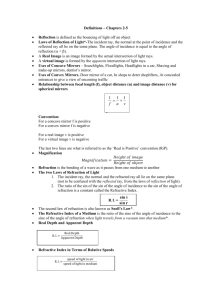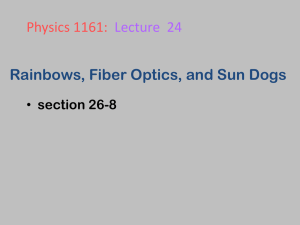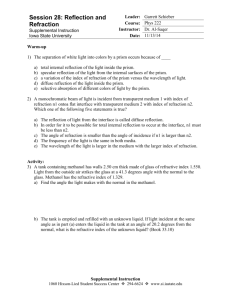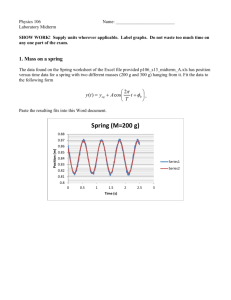HOMEWORK ANSWERS (Light and Geometric Optics)
advertisement
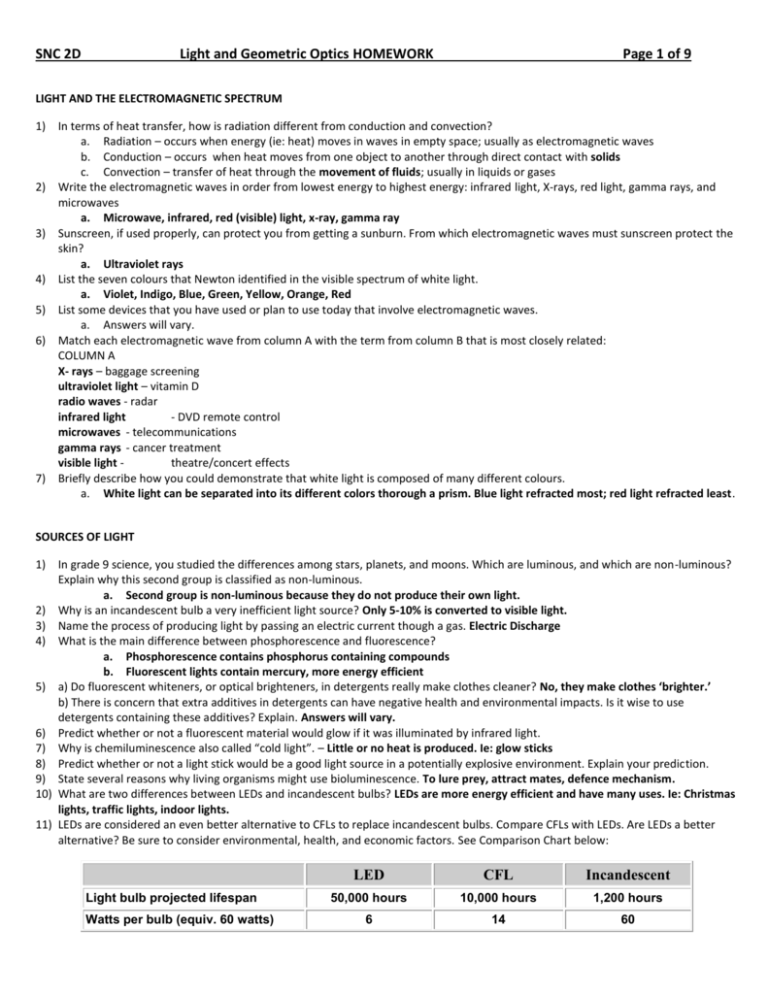
SNC 2D Light and Geometric Optics HOMEWORK Page 1 of 9 LIGHT AND THE ELECTROMAGNETIC SPECTRUM 1) In terms of heat transfer, how is radiation different from conduction and convection? a. Radiation – occurs when energy (ie: heat) moves in waves in empty space; usually as electromagnetic waves b. Conduction – occurs when heat moves from one object to another through direct contact with solids c. Convection – transfer of heat through the movement of fluids; usually in liquids or gases 2) Write the electromagnetic waves in order from lowest energy to highest energy: infrared light, X-rays, red light, gamma rays, and microwaves a. Microwave, infrared, red (visible) light, x-ray, gamma ray 3) Sunscreen, if used properly, can protect you from getting a sunburn. From which electromagnetic waves must sunscreen protect the skin? a. Ultraviolet rays 4) List the seven colours that Newton identified in the visible spectrum of white light. a. Violet, Indigo, Blue, Green, Yellow, Orange, Red 5) List some devices that you have used or plan to use today that involve electromagnetic waves. a. Answers will vary. 6) Match each electromagnetic wave from column A with the term from column B that is most closely related: COLUMN A X- rays – baggage screening ultraviolet light – vitamin D radio waves - radar infrared light - DVD remote control microwaves - telecommunications gamma rays - cancer treatment visible light theatre/concert effects 7) Briefly describe how you could demonstrate that white light is composed of many different colours. a. White light can be separated into its different colors thorough a prism. Blue light refracted most; red light refracted least. SOURCES OF LIGHT 1) In grade 9 science, you studied the differences among stars, planets, and moons. Which are luminous, and which are non-luminous? Explain why this second group is classified as non-luminous. a. Second group is non-luminous because they do not produce their own light. 2) Why is an incandescent bulb a very inefficient light source? Only 5-10% is converted to visible light. 3) Name the process of producing light by passing an electric current though a gas. Electric Discharge 4) What is the main difference between phosphorescence and fluorescence? a. Phosphorescence contains phosphorus containing compounds b. Fluorescent lights contain mercury, more energy efficient 5) a) Do fluorescent whiteners, or optical brighteners, in detergents really make clothes cleaner? No, they make clothes ‘brighter.’ b) There is concern that extra additives in detergents can have negative health and environmental impacts. Is it wise to use detergents containing these additives? Explain. Answers will vary. 6) Predict whether or not a fluorescent material would glow if it was illuminated by infrared light. 7) Why is chemiluminescence also called “cold light”. – Little or no heat is produced. Ie: glow sticks 8) Predict whether or not a light stick would be a good light source in a potentially explosive environment. Explain your prediction. 9) State several reasons why living organisms might use bioluminescence. To lure prey, attract mates, defence mechanism. 10) What are two differences between LEDs and incandescent bulbs? LEDs are more energy efficient and have many uses. Ie: Christmas lights, traffic lights, indoor lights. 11) LEDs are considered an even better alternative to CFLs to replace incandescent bulbs. Compare CFLs with LEDs. Are LEDs a better alternative? Be sure to consider environmental, health, and economic factors. See Comparison Chart below: Light bulb projected lifespan Watts per bulb (equiv. 60 watts) LED CFL Incandescent 50,000 hours 10,000 hours 1,200 hours 6 14 60 SNC 2D Light and Geometric Optics HOMEWORK Cost per bulb Page 2 of 9 $35.95 $3.95 $1.25 KWh of electricity used over 50,000 hours 300 700 3000 Cost of electricity (@ 0.20per KWh) $60 $140 $600 Bulbs needed for 50k hours of use 1 5 42 Equivalent 50k hours bulb expense $35.95 $19.75 $52.50 Total cost for 50k hours $95.95 $159.75 $652.50 RAY MODEL OF LIGHT 1) What is the ray model of light? a. It is a model of light that describes how light travels. It states that light travels in a straight line. A ray represents a single unit of light and is drawn as a straight single arrow. 2) Draw a simple ray diagram of light rays travelling out from a light bulb. See below: 3) What are two properties of light that you can show using a ray diagram? a. Path the light is travelling b. Direction of light 4) What three things can happen with light strikes an object? a. Depending on type of material, light can be transmitted or absorbed: SNC 2D Light and Geometric Optics HOMEWORK Page 3 of 9 5) Use a labeled ray diagram to show the difference between transparent, translucent, and opaque objects. See diagram above. 6) What determines how light rays behave when they strike an object? a. Type of material ie: glass window vs. concrete wall 7) a) Name the two parts that make up most mirrors. Glass and a thin reflective film. b) What is the purpose of each part? To allow for light to reflect. 8) Clearly explain what is meant by the term geometric optics. a. Geometric optics is the study of the use of light rays to determine how light behaves when it strikes objects. 9) Classify each of these materials as transparent, translucent, or opaque: a textbook (opaque), frosted glass (translucent), a single sheet of thin tissue paper (translucent), a clean sheet of glass (transparent), a rock (opaque), clean air (transparent), apple juice (transparent or translucent), sunglasses (transparent). 10) What has historically been the main use for plane mirrors? To reflect images. 11) A basketball does not give off light. Explain with the aid of a ray diagram how you are able to see a basketball. 12) Explain why a piece of metal would make a better reflector than a piece of wood. The surface of a piece of metal is more likely to be smooth, leading to specular reflection. The surface of a piece of wood is more likely to be rough, leading to diffuse reflection. Both would absorb light. 13) Explain, with the help of ray diagrams, why the shadow created by your hand on a wall grows larger when you move your hand toward the light source. 14) Under what conditions can a transparent material become translucent or even opaque? A thin sheet of plastic is transparent. However, if several sheets of plastic are layered on top of one another they will become translucent due to the way that light will bend. If these sheets are increased in number, they may even become opaque. 15) A spotlight shines on an actor on a stage. Describe the type of shadow the actor is likely to cast. The further the spotlight is from the actor, the smaller (and fainter) the shadow will be. LAWS OF REFLECTION AND PLANE MIRRORS 1) In your own words, clearly distinguish between the terms normal, angle of incidence, and angle of reflection. a. Normal – Perpendicular line to a mirror surface b. Angle of incidence – Angle between incident ray and normal c. Angle of reflection – Angle between the reflected ray and normal 2) Using a diagram, distinguish between the incident ray, the reflected ray, and the normal. SNC 2D Light and Geometric Optics HOMEWORK Page 4 of 9 3) Clearly state the two laws of reflection. a. The angle of incidence equals the angle of reflection, i=r b. The angle of incidence and angle of reflection are always measured from the normal and not from the surface of the object 4) a) What is the difference between specular reflection and diffuse reflection? Specular reflection is reflection of light from a smooth surface ; diffuse reflection is reflection of light from an irregular surface. b) Provide some examples of both specular reflection and diffuse reflection other than those given. Specular: glass, wall, table; Diffuse: any rocky surface, grass 5) a) If you were painting the walls in your classroom, would you want the walls to exhibit specular or diffuse reflection? Explain. b) Given your choice, should you use gloss or matte paint? Answers will vary. 6) a) What would be the angle of reflection for an angle of incidence of 32 o? 32 degrees. b) What would be the angle of incidence for an angle of reflection of 47 o? 47 degrees. c) What would the angle of reflection be if the incident ray was 40 o from the reflecting mirror surface? 50 degrees. 7) Specular reflection and diffuse reflection are concepts that can be applied to every room that you have ever been in. Describe how these concepts can be applied to your kitchen, bathroom, and bedroom. Answers will vary. 8) Draw a ray diagram and locate the virtual image of each object: SNC 2D Light and Geometric Optics HOMEWORK Page 5 of 9 CONCAVE MIRRORS Concave Mirrors Worksheet***** 1) List examples of how concave mirrors might be used at your school. a. Science experiments b. entrances and hallways – to avoid bumping into others 2) Describe the difference between a real image and a virtual image. a. Real image – formed when light rays actually meet at the image b. Virtual image – an image formed in a location where light does not actually reach. Ie: reflection in a mirror 3) Use a diagram to locate the focus in a concave mirror. The focus is the midpoint of C and V: 4) In your own words, state the imaging rules for concave mirrors. Answers will vary. 5) You are looking at your image in a makeup or shaving mirror. Where is your head located with respect to the focus (F). a. Images in these mirrors will be magnified and virtual, so it would have to be between V and F. CONVEX MIRRORS Convex mirrors worksheet ***** 1) List examples of how convex mirrors might be used at your school. a. Answers will vary. 2) Why will a diverging (convex) mirror never produce a real image? Include a diagram in your explanation. a. The rays of light will always meet behind the mirror. As a result, the image will always be virtual. 3) What is the relationship between type and the attitude of an image? a. Convex mirrors will always have an upright and virtual iamge. 4) a) Why are convex mirrors placed on sharp turns in parking garages? a. To allow for traffic to be seen coming from opposing lanes. 4b) State other uses for convex mirrors. Cell phones CURVED MIRROR CALCULATIONS 1) See notes 2) +, image in front of mirror; -, image behind mirror 3) 1.7 cm (inverted), 9.2 cm (real) 4) A focal length of 25 cm and distance of 30 cm will only yield an inverted image (-) 5) Real, + di, Virtual, -di 6) 0.7 m (virtual), 0.1 m (upright) 7) 0.5 m (virtual), 0.2 m (upright) 8) 0.2 m (virtual), 0.1 m (upright) 9) 0.7 m (virtual), 0.1 m (upright) 10) 38.7 cm (virtual), 12.1 cm (upright) SNC 2D Light and Geometric Optics HOMEWORK Page 6 of 9 INDEX OF REFRACTION AND SNELL’S LAW 1) The speed of light in leaded glass is 1.66x108m/s. What is the index of refraction of this type of glass? n = c/v c =3.0 X 108 m/s v = 1.66x108m/s Therefore, n = 1.81 2) The speed of light in quartz is 2.1x108m/s. What is the index of refraction of quartz? n= c/v ( c = 3.0 X 108 m/s ; v = 2.1x108m/s ) Therefore, n = 1.43 3) The speed of light through a material is 1.24x108m/s. What material is it? Diamond 4) What is the speed of light through ethyl alcohol? n= 1.36 c = 3.0 X 108 m/s v=? v = c/n v = 3.0 X 108 m/s / 1.36 v = 2.20 X 10 8 m/s Therefore, the speed of light is 2.20 X 10 8 m/s. 5) What is the speed of light through vegetable oil? 2.04 X 108 m/s 6) What is the speed of light through a diamond? 1.24 X 108 m/s 7) When light passes from air into water at an angle of 30o from the normal, what is the angle of refraction? n1 sin i n 2 sin R 1.0 sin 30 = 1.33 sin R Therefore, the angle of refraction is 22.1 degrees. from water into a diamond at an angle of 45o from the normal, what is the angle of refraction? 8) When light passes n1 sin i n 2 sin R 1.33 sin 45 = 2.42 sin R Therefore, the angle of refraction is 22.9 degrees. 9) The refractive index of the lens in a human eye s 1.41. If a ray of light goes from the air into the lens at an angle of 55.0 o, what is the angle of refraction? n1 sin i n 2 sin R 1.0 sin55 = 1.41 sin R Therefore, the angle of refraction in 35.5 degrees. 10) A ray of light approaches a jar of honey at an angle of 30.0o. If the angle of refraction is 19.5o, what is the refractive index of honey? n1 sin i n 2 sin R SNC 2D Light and Geometric Optics HOMEWORK Page 7 of 9 1.0 sin 30 = n2 sin19.5 1.50 = n Therefore, the refractive index for honey is 1.50. 11) A block of amber is placed in water and a laser beam travels from the water through the amber. The angle of incidence is 35 o while the angle of refraction is 24o. What is the index of refraction of amber? n1 sin i n 2 sin R 1.33 sin35 = n2 sin24 1.88 = n2 Therefore, the index of refraction is 1.88. 12) A red laser beam travels from Plexiglass into lemon oil. The angle of incidence is 40.0 o and the angle of refraction is 44.4o. What is the refractive index of lemon oil? n1 sin i n 2 sin R 1.49 sin40 = n2 sin44.4 n2 = 1.37 Therefore, the refractive index for lemon oil is 1.37. CRITICAL ANGLE AND TOTAL INTERNAL REFLECTION 1) 2 conditions that must be fulfilled: a. Light is travelling more slowly in the first medium than in the second medium b. The angle of incidence is large enough that no refraction occurs in the second medium. Instead, the ray is reflected back into the first medium. 2) This would depend on the type of medium and how dense the medium is. Light has to travel away from the normal (past the critical angle) for TIR to occur. 3) B and c 4) A prism will reflect almost 100% of the light internally. (mirrors will absorb some, and the reflective surface deteriorates over time) 5) You will get more TIR with a medium that has a small critical angle. 6) Answers will vary. 7) B and C 8) (a) medium B ; (b) medium B; (c) medium A CONVERGING AND DIVERGING LENSES 1) Lenses have a wide variety of application. They are not only used for glasses. They can be found in telecommunications, construction, etc. 2) Converging lens – causes light rays to come together at a single point Diverging lens – causes light rays to spread apart after refraction SNC 2D Light and Geometric Optics HOMEWORK Page 8 of 9 3) As a light ray is travelling through a lens, there are always two refractions. a. Light is refracted at the first air to glass surface b. Light then travels through the glass of the lens and is refracted again at the glass to air surface on the other side 4) There is only one principal focus for a converging lens. 5) Yes - Converging lens – thickest in the middle Diverging lens – thinnest in the middle 6) a. on the opposite side as the incident rays b. same side of the lens as the incident rays c. A converging lens brings parallel light rays together through a focus after refraction. A diverging lens spreads parallel rays apart after refraction so that it looks as if they have come from a virtual focus. Images in Lenses 1) a) Answers will vary. b) A third ray is added. All three rays must meet at one point – this is where the image will be. 2) A diverging lens only produces a virtual image because the image will always appear between the object and the lens. Light rays can never meet when they are refracted as they leave the lens- they will only get further apart in a diverging lens. 3) Virtual image produced by a converging lens is always larger, upright, and beyond the object. 4) Answers will vary. 5) Answers will vary depending on the type of projector. Human Eye 1) - Both have lenses (converging lenses) -pupil of the human eye can adjust light, similar to a shutter in a camera -Both can focus on an image that is either close up or further away (not both at the same time) -Both capture images. A camera uses film to capture an image; The eye uses the retina which contains rods and cones to capture an image 2) Our brain processes what the eye sees. 3) Parts of eye responsible for viewing objects are: - pupil – where light enters the eye - cornea – refracts light into the eye - lens – causes light to focus on the retina - retina – picks up the image and sends it to the brain 4) Ciliary muscles adjust with the fine tuning. These are muscles in humans that change the shape of the eye lens depending on how far away an object appears (near vs. distance vision). 5) We do not see everything in our view upside down. The image appears upside down in the retina. However, the brain interprets the image correctly. 6) Answers will vary. Some diseases are cataracts, glaucoma, retinoblastoma. SNC 2D Light and Geometric Optics HOMEWORK Page 9 of 9 Color Theory 1) Explain how Newton separated white light. Newton used two prisms to show that white light can be separated into colored light, and recombined to form white light. 2) Describe the additive color theory in your own words. This is the theory that white light is formed by combining the three primary colours of light, and that the secondary colours of light are formed by combining two primary colours. Give an example of secondary color light under additive color theory and tell how it can be formed. These are colors of light that are formed by combining two primary colors of light. Ie: Yellow, cyan, and magenta. 3) 4) Define ‘complimentary colors of light’. Any two colors of light that appear white when mixed together. Ie: Green + magenta = white 5) Identify and explain the types of cells found on the retina. 2 types of cells: - rods – sensitive to levels of light, for night vision - cones - sensitive to color; 3 types – red, green, blue 5) Describe the subtractive color of theory in your own words. Theory which states that non-luminous objects appear colored because they absorb certain colors of light and reflect or transmit other colors of light. 6) What is the main difference between the additive and subtractive color theory? a. Additive – mixture of all colors forms white light; used in television screens and computer monitors b. Subtractive – mixture of all colors forms black; used in non-luminous objects ie: jeans




